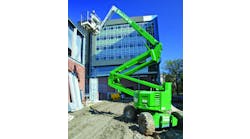Too much economic uncertainty is bad for the rental industry in that nobody wants to invest and construction grinds to a halt, a scenario we saw a few years ago. However, repeated cycles have shown that a certain amount of uncertainty tends to be good for the rental market. The lack of clear visibility makes companies hesitant to outlay large capital expenditures, thus making rental by far the safer way to obtain equipment for jobs. That along with a number of other advantages we’ve all been touting for years, such as having access to the latest innovations from the modern fleets of rental companies, not having to be responsible for maintenance and storage of equipment, reducing fixed costs and many other benefits.
Utilization is fairly strong overall in the industry right now and the average age of a lot of fleets is still relatively high. Given that housing is picking up, as is non-residential spending, albeit more slowly than desired, rental companies are likely to continue to spend for replacement, and a certain amount of fleet spending for growth is taking place as well.
Rental companies are expanding. Take a look. United Rentals has opened some branches; Sunbelt Rentals and NES have made acquisitions; some Caterpillar dealers are building new and bigger facilities. Although there is still caution, confidence in the rental industry is increasing.
The energy markets have clearly become the leading driver, and we’ll have more about that in upcoming issues. With shale gas being discovered in so many states, more and more companies are having access to those markets. For some companies, it’s been a bit like Jed Clampett finding black gold flowing on his property. But energy markets aren’t for everybody. You can’t supply oil-and-gas exploration or shale energy work if it isn’t happening in your area, and it’s not a great time in the coal industry. Still, energy could be the leading driver for the U.S. economy for the foreseeable future.
Small business owners, generally, are more optimistic. U.S. manufacturing is reviving. According to noted economist Eli Lustgarten of Longbow Research, in a presentation at last month’s AED Executive Forum, construction activity should continue to improve in 2014 driven by further growth in housing and higher spending in private non-residential markets. Lustgarten expects double-digit growth in light equipment demand in 2014, but a 5- to 10-percent decline in larger equipment led by continued soft mining demand. Multi-family housing looks to be the strongest area in the foreseeable future in housing, while commercial construction and industrial is looking fairly favorable for the next year or so.
Private non-residential construction is likely to rise 10 to 15 percent, led by power, pipeline, manufacturing, warehouses, high education, data centers and hotels with minimal activity in office and retail. Meanwhile, public non-residential looks soft with highway, educational and transportation showing weakness as federal funds decline, Lustgarten’s research shows.
Residential should be up at least 10 to 15 percent this year, with multi-family stronger than single-family, and remodeling should be up some as well. Total construction should continue to rise from 6- to 10-percent annually between now and 2018. If that prediction holds, and rental penetration continues to hold at 50 percent or even higher, there should be a lot of opportunities ahead for rental companies. Energy growth might take it even higher. Unless of course unforeseen disasters, such as the current one in Washington, create challenges we haven’t thought of yet.
If we can get through the next 12 to 18 months, Lustgarten says, the U.S. potentially has one of the most favorable three-to-five year outlooks, with the U.S. becoming a net energy exporter with low-cost energy supplies, and low-cost feedstock for industrial products. The amount of construction work supporting the oil-and-gas industry is potentially staggering. We’ll see soon where it all goes.
* * *
I imagine many of you already know that Don Ahern’s Xtreme Manufacturing has acquired a majority ownership of Snorkel, although the deal is yet to be finalized (see story at http://rermag.com/manufacturers/ahern-s-xtreme-manufacturing-agrees-acquire-majority-interest-snorkel). At press time, Snorkel shareholders have approved the deal. We’ll be taking a deeper look at where Snorkel will be going in upcoming issues. rer







